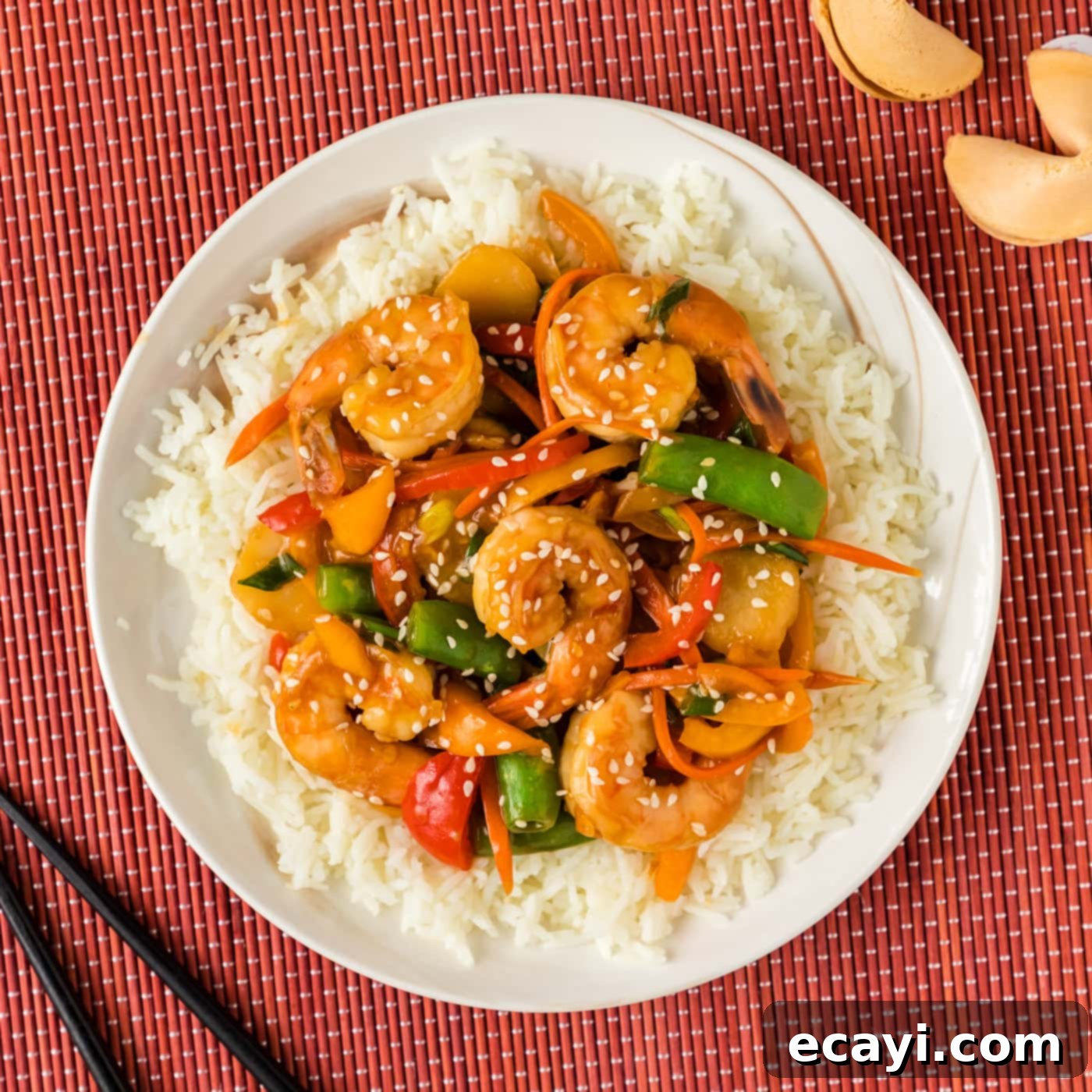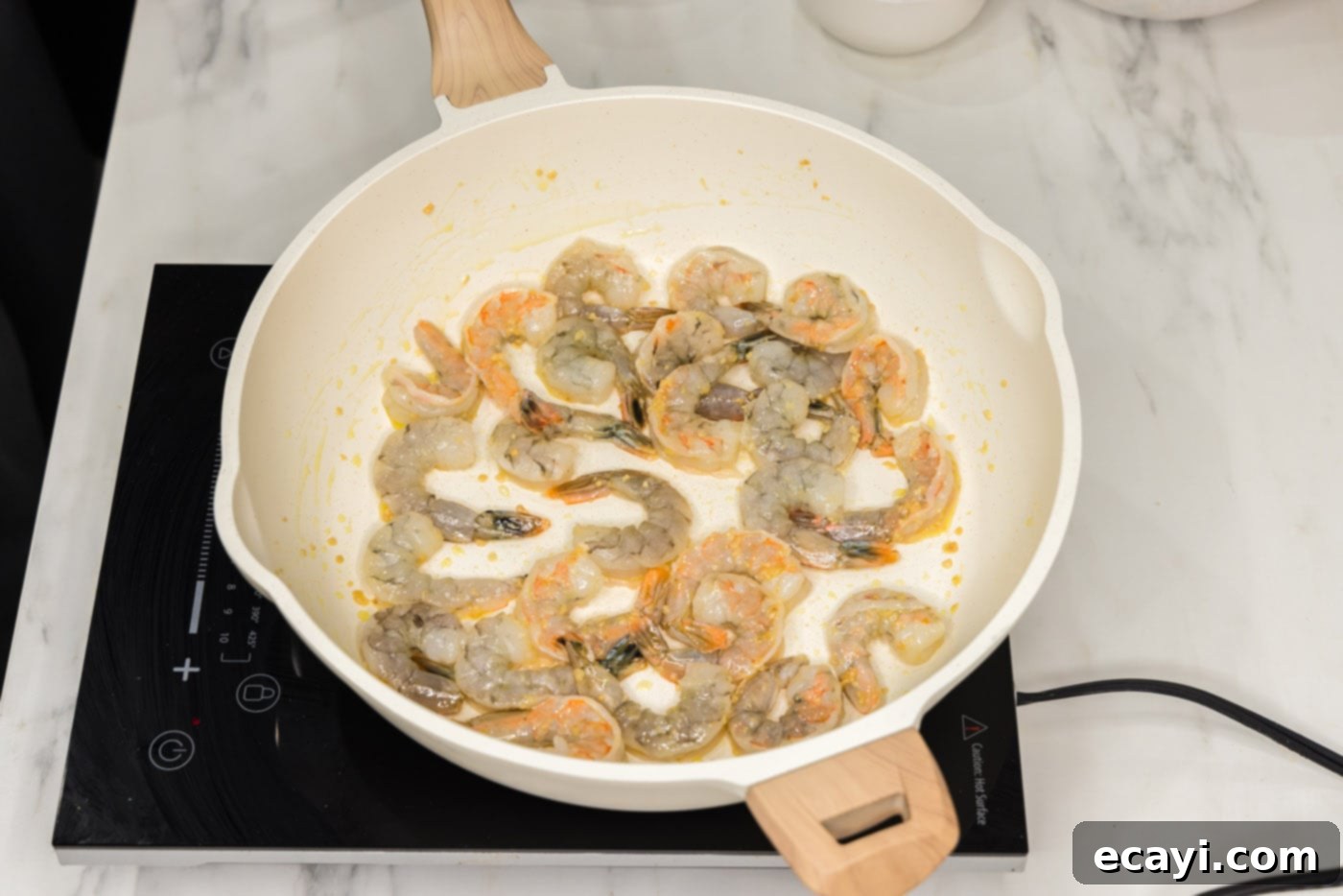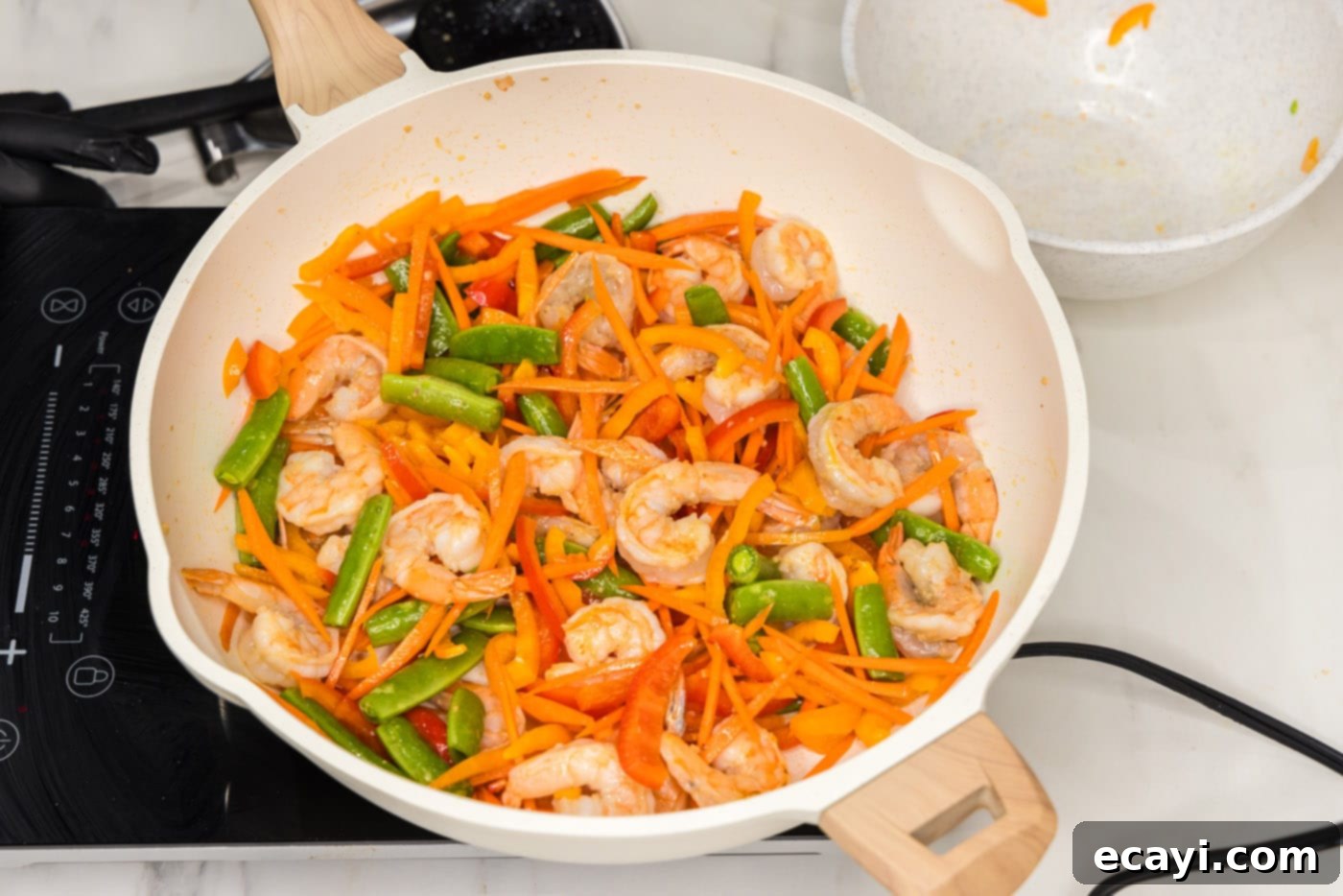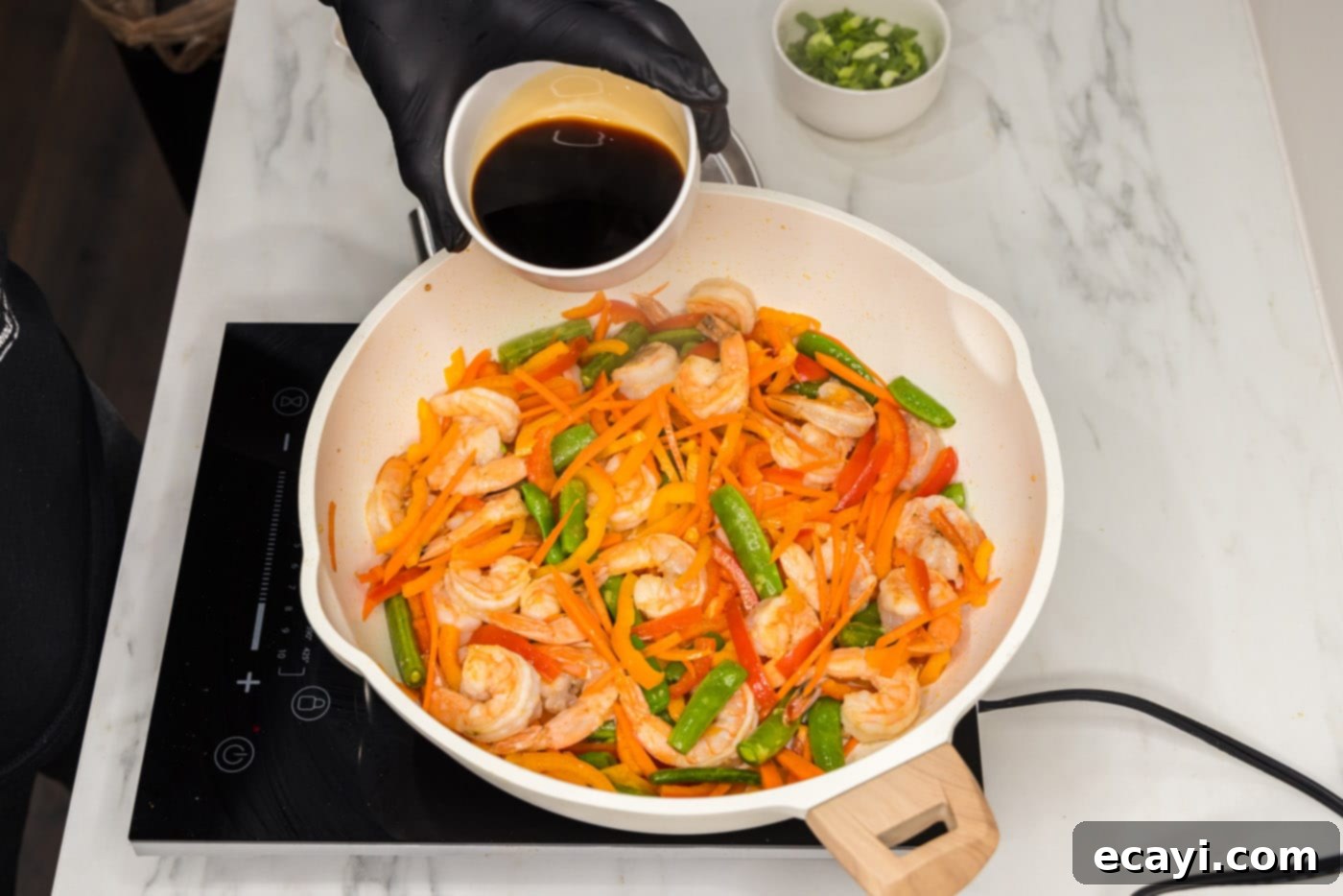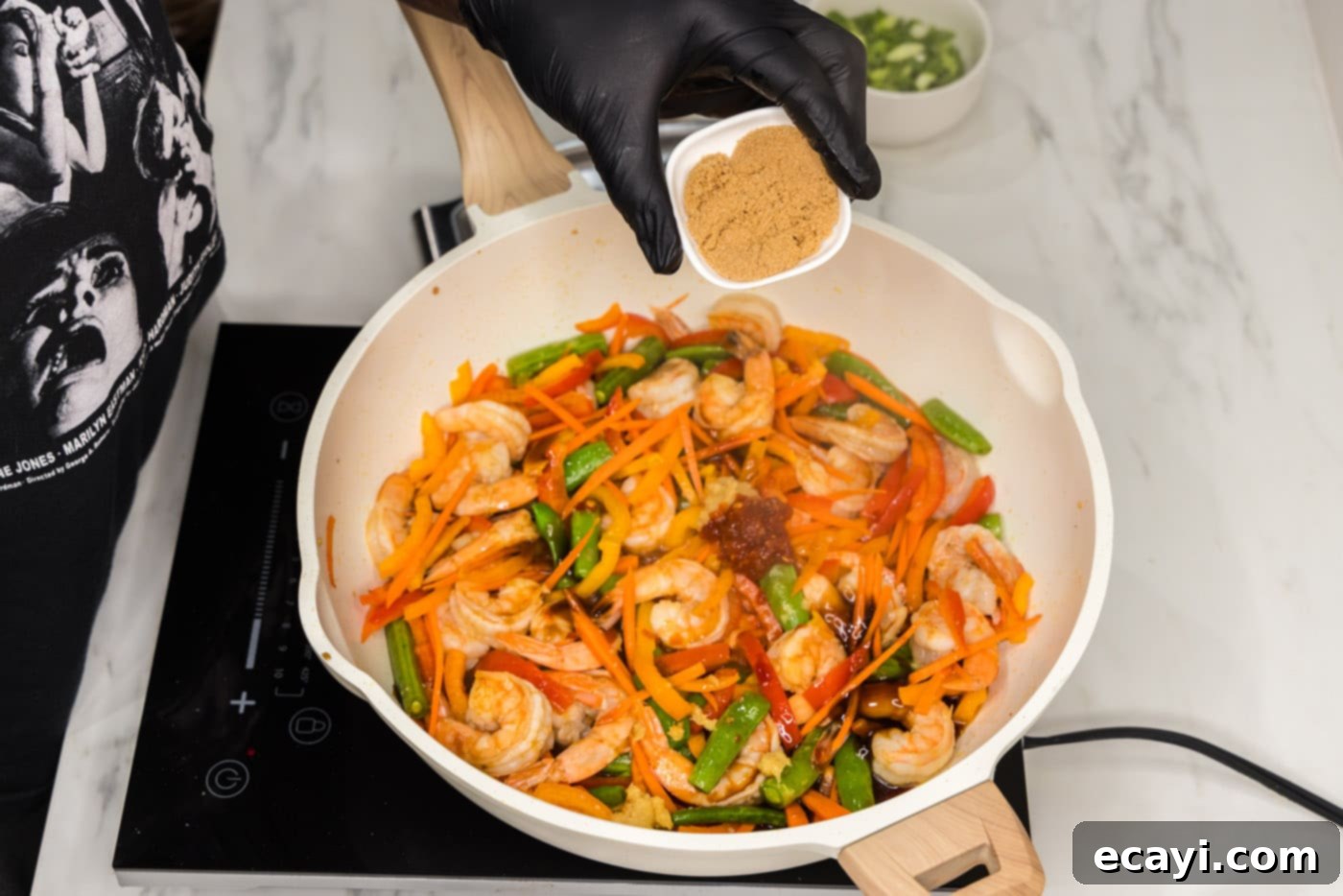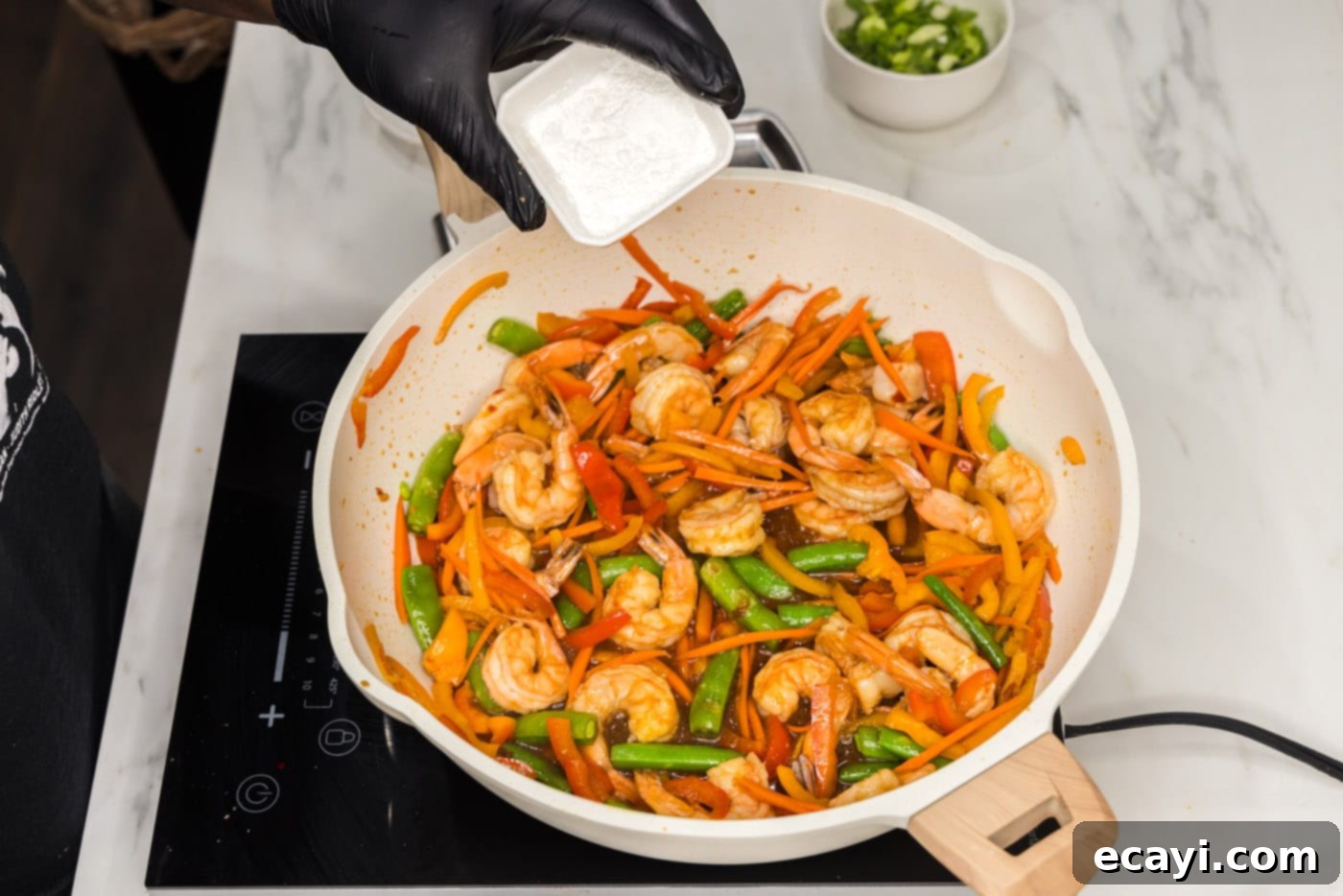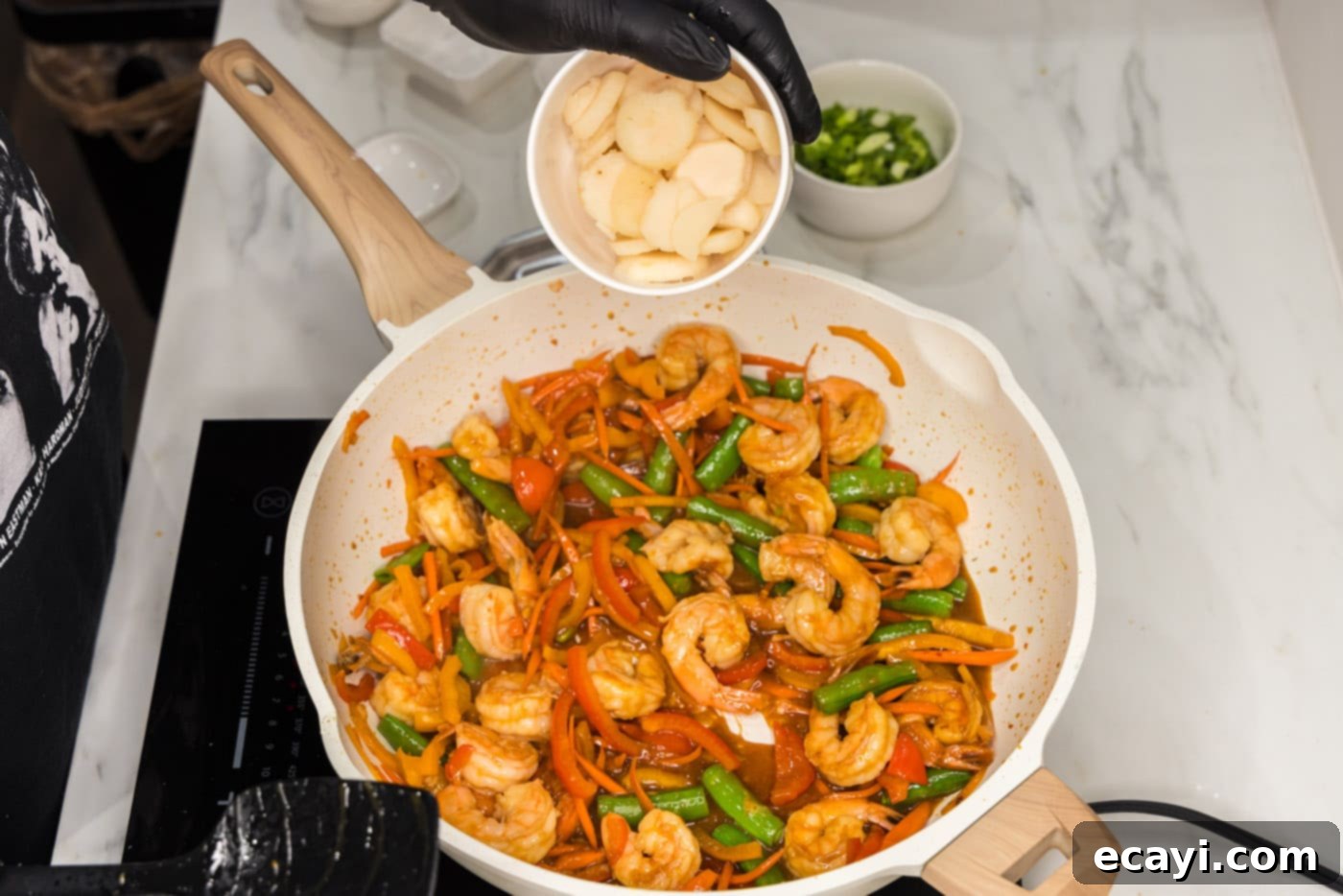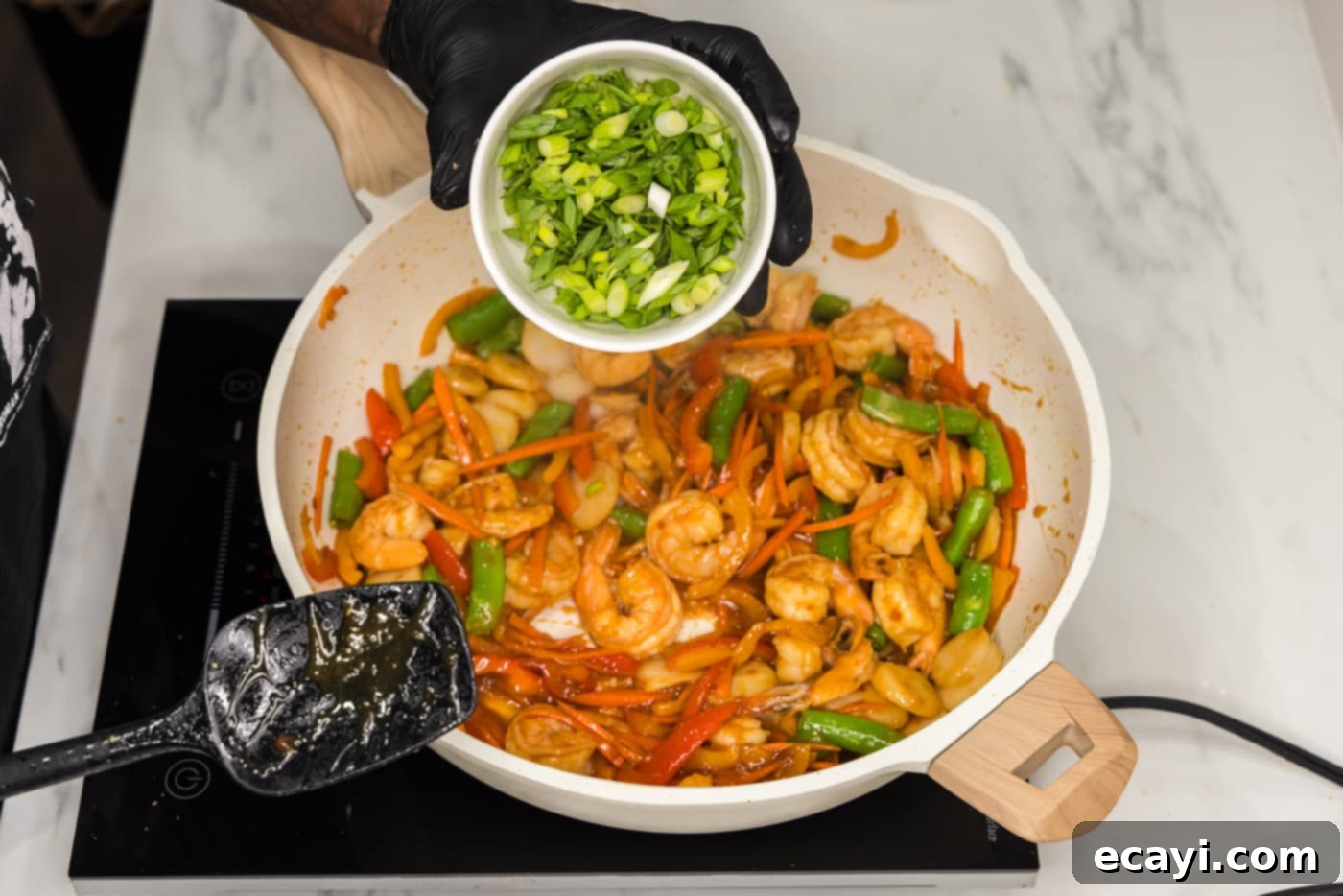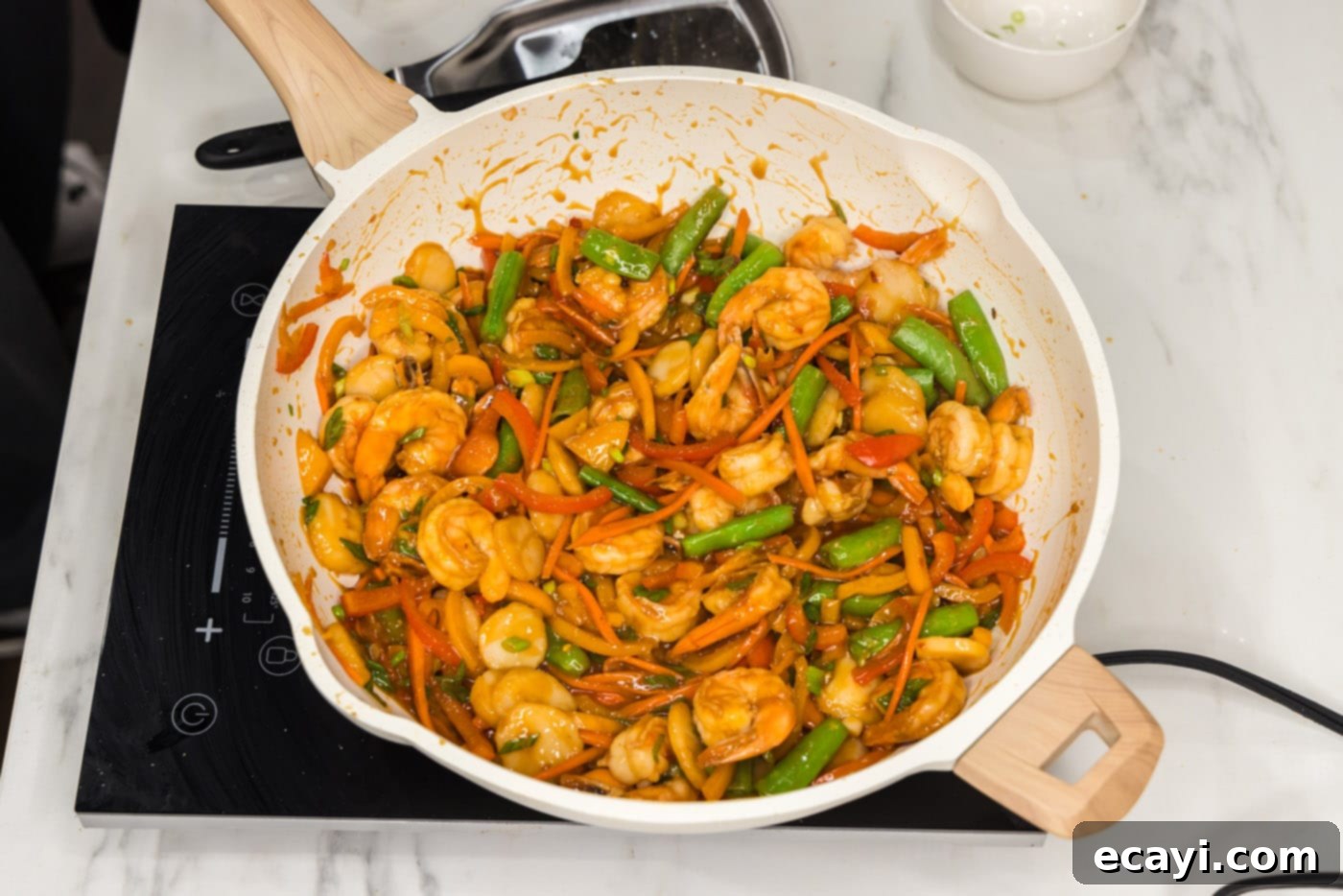Easy & Flavorful Shrimp Stir Fry: Your Ultimate Weeknight Dinner Solution
Transform your dinner routine with this incredibly easy and vibrant shrimp stir fry recipe. Featuring succulent shrimp, crisp carrots, colorful bell peppers, tender snap peas, and crunchy water chestnuts, all bathed in a rich, savory, and umami-packed sauce, this dish promises a mouth-watering experience. It’s a perfect blend of fresh ingredients and bold flavors, designed for both speed and satisfaction, making it an ideal choice for busy weeknights or whenever you crave a delicious homemade meal.
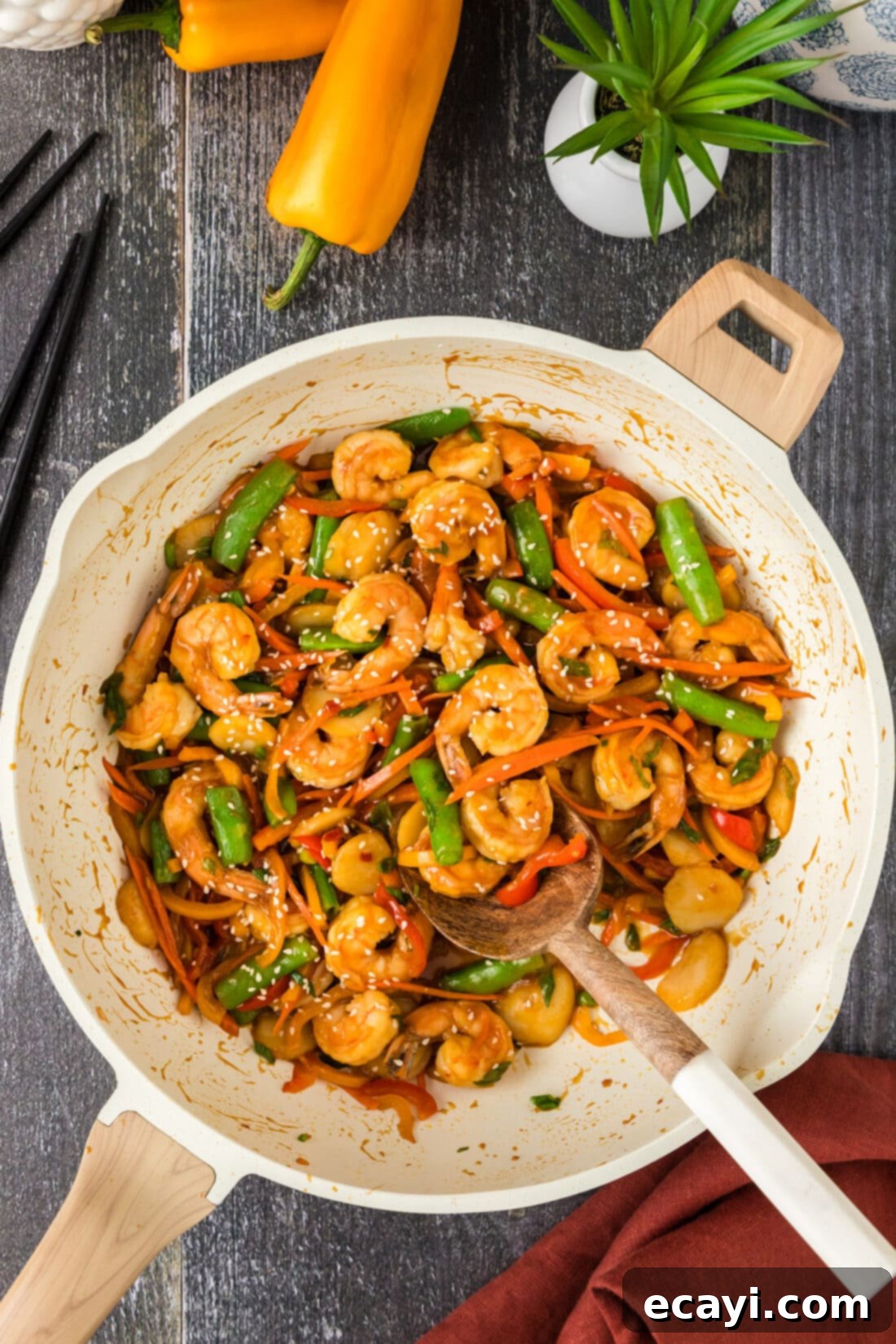
Why This Easy Shrimp Stir Fry Recipe Will Become Your New Favorite
Shrimp stir fry is a cornerstone of quick and healthy weeknight cooking, and this particular recipe truly shines. It’s not just “easy” – it’s designed for maximum flavor impact with minimal effort, coming together in less than 35 minutes from start to finish. Here’s what makes this recipe a winner:
- Speed and Simplicity: Stir-frying is one of the fastest cooking methods, and shrimp cooks in a flash. With a bit of strategic prep, you can have a gourmet-quality meal on the table faster than ordering takeout. This recipe streamlines the process, ensuring a hassle-free cooking experience even on your busiest days.
- Vibrant and Nutritious: We’ve carefully selected a colorful mix of stir-fry vegetables – crisp carrots, bright bell peppers, sweet snap peas, and delicate water chestnuts – to add not only stunning visual appeal but also a fantastic array of textures and essential nutrients. Each bite offers a delightful crunch and a burst of freshness, contributing to a balanced and wholesome meal.
- Unforgettable Flavor Profile: The secret to this stir fry lies in its exceptional sauce. It’s a perfectly balanced concoction of soy sauce, savory oyster sauce, aromatic sesame oil, pungent minced ginger, a touch of brown sugar for sweetness, and a mild kick from Asian sweet chili sauce. This combination delivers a complex, umami-rich flavor that is incredibly satisfying and reminiscent of your favorite Asian restaurant dishes, such as hibachi shrimp. The cornstarch acts as a thickening agent, ensuring the sauce coats every ingredient beautifully, creating a glossy, irresistible finish.
- Versatility at Its Best: While we love the combination of ingredients in this recipe, it’s incredibly adaptable. You can easily swap out vegetables based on what you have on hand or what’s in season, and even explore different protein options (see our FAQs for suggestions!).
This shrimp stir fry isn’t just a meal; it’s a testament to how delicious and wholesome home cooking can be, even when time is of the essence. Get ready to impress your taste buds and simplify your dinner routine!
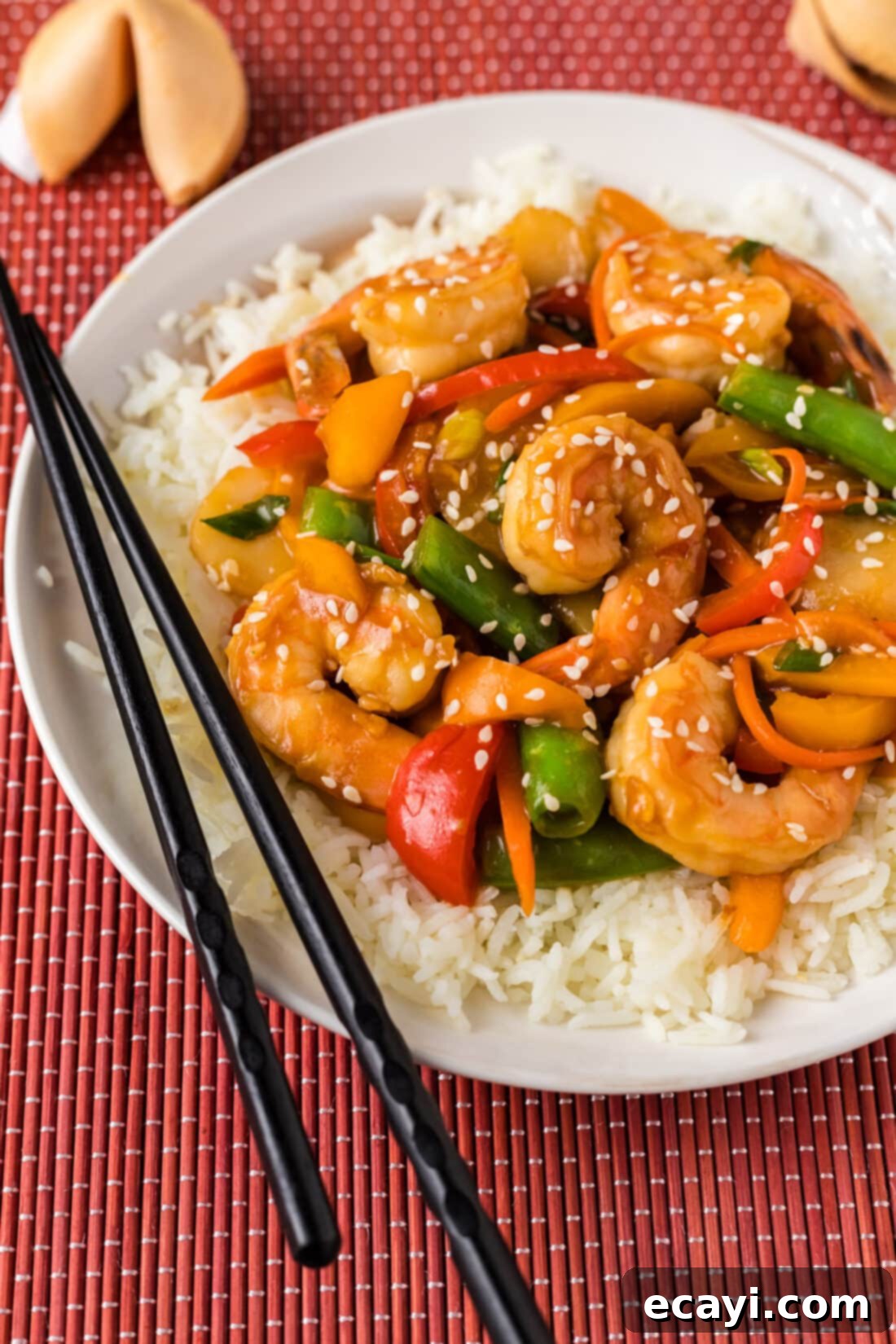
Essential Ingredients for Your Perfect Shrimp Stir Fry
Crafting a truly exceptional shrimp stir fry begins with selecting the right ingredients. While the full list with precise measurements and detailed instructions can be found in the printable recipe card at the end of this post, let’s explore the key components that bring this dish to life. Think of stir-frying as a dynamic dance – each ingredient plays a crucial role in creating a harmonious balance of flavors and textures.
For the freshest and most flavorful results, we always recommend using high-quality ingredients. From plump, fresh shrimp to crisp, vibrant vegetables and a rich, savory sauce, every element contributes to the overall deliciousness of this quick and healthy weeknight meal. Gather your ingredients, and let’s get ready to stir up some magic!
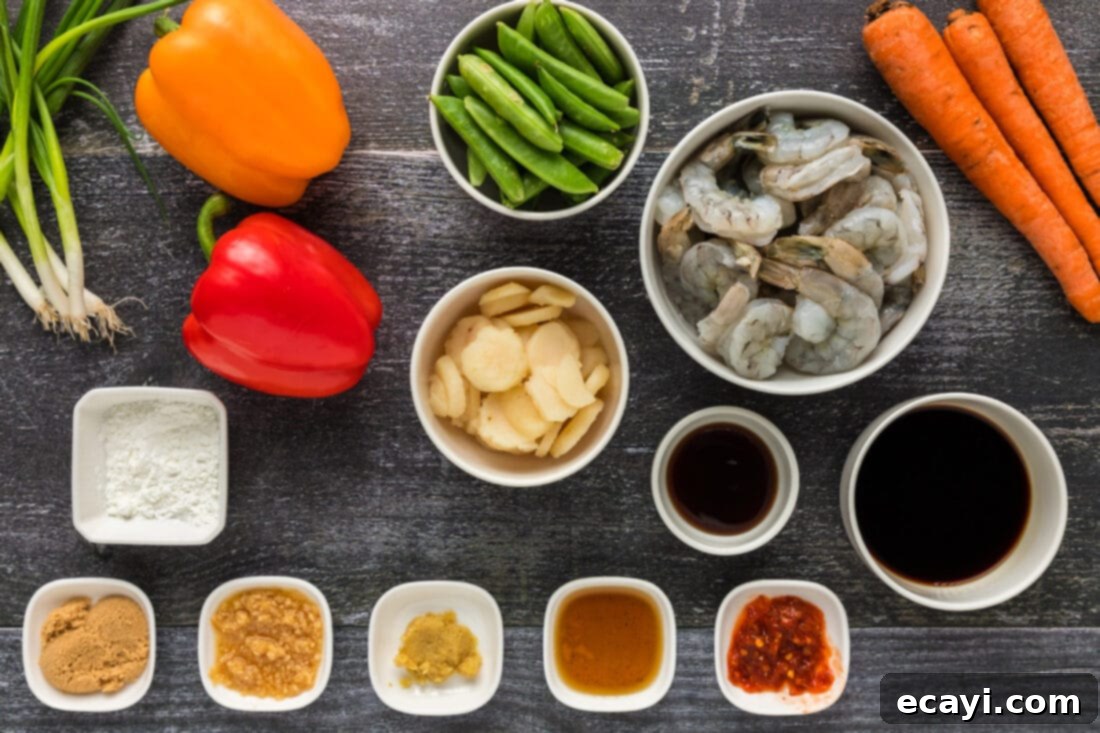
Deep Dive into Ingredients & Smart Substitutions
Understanding each ingredient and its role is key to mastering any recipe. Here’s a closer look at what goes into our shrimp stir fry and how you can tailor it to your preferences or what you have available.
SHRIMP – The Star of the Show
For this recipe, we recommend using large raw shrimp, peeled and deveined. While we left the tails on for presentation in our photos – which adds a nice visual touch – this is entirely optional. Feel free to remove the tails before cooking if you prefer a more convenient eating experience. The most important tip for shrimp is to avoid using precooked shrimp. Precooked shrimp tend to become rubbery and tough when stir-fried, as they will be cooked twice. Opting for raw shrimp allows you to achieve that perfect tender-crisp texture. If using frozen shrimp, always thaw them completely and pat them dry before cooking to prevent excess water from steaming rather than stir-frying your dish.
THE SAUCE – A Symphony of Savory Flavors
The sauce is arguably the heart of any good stir fry, and ours is designed to deliver a perfectly balanced, umami-rich experience with a delightful mild kick. Its flavor profile is wonderfully complex, echoing the delectable taste of popular Asian-inspired dishes. Here’s a breakdown:
- Soy Sauce: Provides the fundamental savory, salty, umami base. We generally recommend a good quality regular or low-sodium soy sauce.
- Oyster Sauce: This is a powerhouse of umami, adding depth and a subtle sweetness that elevates the entire dish. Don’t skip it if you want authentic flavor!
- Sesame Oil: Used for its distinctive nutty aroma and flavor, a little goes a long way. Add it towards the end or as part of the sauce for maximum impact.
- Minced Ginger: Fresh ginger provides a pungent, zesty warmth that is essential to Asian cuisine. Freshly minced is always best for the brightest flavor.
- Brown Sugar: Balances the savory and spicy notes, adding a touch of sweetness and helping the sauce caramelize slightly.
- Asian Sweet Chili Sauce: This is where the “mild kick” comes from. It adds sweetness, a hint of heat, and a lovely tang. If you prefer more heat, you can increase the amount or add a dash of sriracha or red pepper flakes. Its flavor is wonderfully complementary to the shrimp and vegetables.
- Cornstarch: This essential ingredient acts as a thickening agent. It ensures the sauce clings beautifully to every piece of shrimp and vegetable, creating that desirable glossy finish without being watery.
You can whisk all the sauce ingredients together ahead of time and store them in the refrigerator, making prep even faster when it’s time to cook.
VEGETABLES – Color, Crunch, and Nutrients
Our recipe calls for a vibrant mix, but the world of stir-fry vegetables is vast. The key is to cut them into similar sizes to ensure even cooking.
- Carrots (julienned): Add sweetness, color, and a pleasant crunch.
- Bell Peppers (red and yellow, julienned): Provide sweetness, vibrant color, and a tender-crisp texture.
- Snap Peas: Offer a sweet, fresh crunch that’s truly delightful.
- Water Chestnuts (sliced): A secret weapon for texture, these add an incredible, unique crispness that stands up well to cooking.
- Green Onions (sliced): Added at the very end, they provide a fresh, mild onion flavor and a pop of green.
Substitution Suggestions for Vegetables: Feel free to customize! Excellent additions include broccoli florets, sliced mushrooms, bok choy, asparagus, baby corn, snow peas (instead of snap peas), thinly sliced onions, zucchini, bamboo shoots, or edamame. Remember to add harder vegetables like broccoli and carrots earlier, and softer ones like mushrooms and bok choy later in the stir-frying process.
Step-by-Step: How to Make Shrimp Stir Fry
These step-by-step photos and instructions are here to help you visualize how to make this delicious recipe. For precise measurements and a printable version, you can always Jump to Recipe at the bottom of this post.
Before you begin, ensure all your ingredients are prepped and ready (this is called “mise en place” and is crucial for successful stir-frying!). Chop your vegetables, peel and devein your shrimp, and whisk together your sauce ingredients. This preparation will make the cooking process incredibly smooth and quick.
- Heat the olive oil in a large deep-sided skillet or wok over medium-high heat. Once hot, add the minced garlic and raw shrimp. Stir fry for just 1-2 minutes, tossing frequently, until the shrimp begins to turn pink and opaque. It’s important not to overcrowd the pan; cook the shrimp in batches if necessary to ensure it stir-fries rather than steams.

- Add the julienned carrots, bell peppers (red and yellow), and snap peas to the skillet with the shrimp. Continue to stir fry for another 2-3 minutes, tossing everything together to ensure even cooking. The vegetables should be tender-crisp, maintaining some of their bite and vibrant color.

- Now, it’s time for the flavor! Pour in the whisked sauce, which includes soy sauce, oyster sauce, sesame oil, minced ginger, Asian sweet chili sauce, and brown sugar. Stir and toss vigorously to combine all ingredients well, ensuring the sauce evenly coats the shrimp and vegetables. The heat of the pan will start to thicken the sauce almost immediately.


- To finalize the texture and flavor, sprinkle the cornstarch directly over the contents of the skillet and toss well. The cornstarch will quickly dissolve and further thicken the sauce to a beautiful, glossy consistency. Finally, add the sliced water chestnuts for their signature crunch and the fresh green onions for a bright, aromatic finish. Toss everything one last time and continue cooking for just 1-2 minutes to ensure all ingredients are heated through and the sauce is perfectly thickened. Serve immediately and enjoy!




Frequently Asked Questions & Expert Tips for the Best Stir Fry
Here are some common questions and essential tips to help you perfect your shrimp stir fry and troubleshoot any culinary queries:
Absolutely! This recipe is incredibly versatile. Feel free to toss in your favorite stir-fry veggies such as bok choy, asparagus, baby corn, broccoli florets, sliced mushrooms, snow peas, or thinly sliced onions. Add harder vegetables like broccoli or carrots earlier in the cooking process, typically when adding the carrots, bell peppers, and snap peas to the pan, to ensure they cook to a tender-crisp consistency. Softer vegetables like mushrooms or bok choy can be added a bit later, as they cook more quickly.
Yes, you can certainly use uncooked frozen shrimp for this recipe. However, it is crucial to thaw them completely before you begin cooking. A quick thawing method is to place the frozen shrimp in a sealed ziptop bag and submerge them in a bowl of cold water for 20-30 minutes, or until fully defrosted. Once thawed, pat the shrimp thoroughly dry with paper towels. Removing excess moisture is key to achieving a good sear during stir-frying and preventing the dish from becoming watery.
Shrimp cooks very quickly, making it easy to overcook. You’ll know shrimp is perfectly done when it curls into a “C” shape and turns opaque with vibrant pink and orange hues. Overcooked shrimp will typically curl tightly into an “O” shape and become rubbery and tough in texture, so keep a close eye on them during the brief cooking time.
To store any cooled leftovers, transfer them to an airtight container and keep it in the refrigerator for up to 3 days. When reheating, you can gently warm it in a skillet over medium heat or in the microwave until heated through. Be careful not to overcook the shrimp during reheating.
Absolutely! Preparing the sauce ahead of time is an excellent way to save time on busy weeknights. Simply whisk all the sauce ingredients together and store them in an airtight container in the refrigerator for up to 3-4 days. Give it a good whisk again before using, as the cornstarch might settle.
For stir-frying, it’s best to use an oil with a high smoke point. Good options include olive oil (as used in this recipe), canola oil, vegetable oil, grapeseed oil, or peanut oil. These oils can withstand the high temperatures required for proper stir-frying without burning and imparting off-flavors.
The Asian sweet chili sauce provides a mild and pleasant heat. If you prefer more spice, you can increase the amount of sweet chili sauce or add a pinch of red pepper flakes, a dash of sriracha, or a few slices of fresh chilies with the garlic. For a milder version, simply reduce the amount of sweet chili sauce or omit it entirely if you’re very sensitive to heat.
Yes, this stir fry base works beautifully with other proteins. Cubed chicken breast or thigh, thinly sliced beef (like flank steak or sirloin), or firm tofu (pressed and cubed) are all excellent substitutes. Adjust cooking times accordingly: chicken and beef will take longer than shrimp, and tofu should be pan-fried until golden brown before adding vegetables.
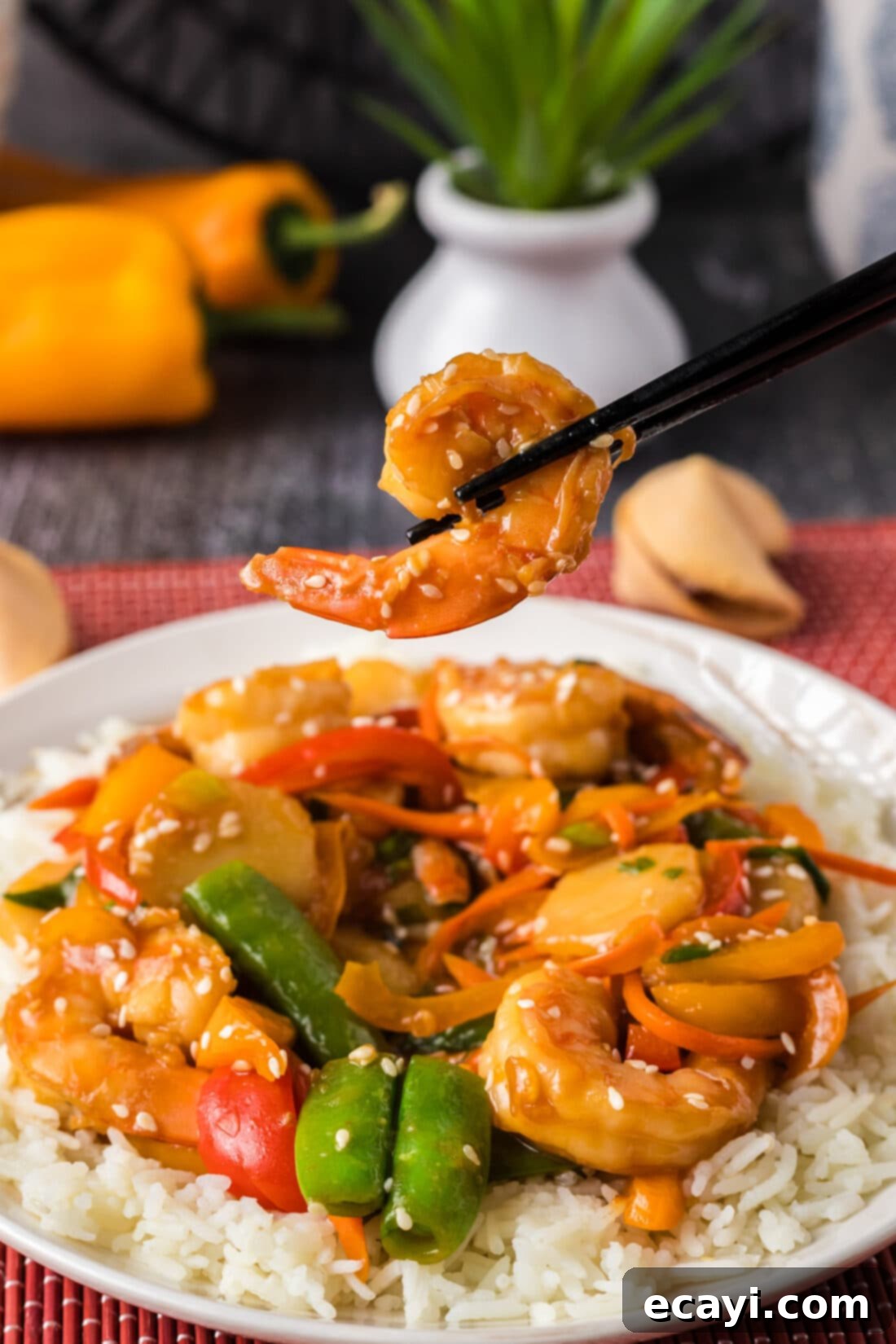
Delicious Serving Suggestions for Your Shrimp Stir Fry
A perfectly cooked shrimp stir fry deserves an equally delicious accompaniment. Here are some fantastic ways to serve this vibrant dish:
- Classic Rice: The most popular pairing! Serve your shrimp stir fry over a generous bed of fluffy white rice, brown rice, or even jasmine rice to soak up every last drop of that savory sauce.
- Noodle Bowls: For a heartier meal, serve it over cooked lo mein noodles, ramen noodles, or even thin rice vermicelli. The noodles provide another wonderful texture and make for a fulfilling dish.
- Low-Carb Options: If you’re watching your carb intake, cauliflower rice is an excellent substitute that still allows you to enjoy the delicious flavors of the stir fry. You could also serve it simply on its own, allowing the vegetables to shine.
- Garnish Galore: Elevate your presentation and add extra flavor with a sprinkle of toasted sesame seeds, chopped fresh cilantro, a drizzle of extra sesame oil, or a squeeze of fresh lime juice just before serving. A few crushed peanuts can also add a delightful crunch and nutty flavor.
No matter how you choose to serve it, this shrimp stir fry is guaranteed to be a hit!
Craving More Shrimp? Explore These Recipes!
If you’ve enjoyed this delightful shrimp stir fry, you’re in for a treat! Shrimp is a wonderfully versatile ingredient, perfect for quick meals and packed with flavor. Discover more ways to enjoy this delicious seafood with some of our other popular shrimp recipes:
- Kung Pao Shrimp – A spicy and savory classic.
- Citrus Pepper Shrimp – Bright, zesty, and full of flavor.
- Garlic Butter Shrimp – A simple yet incredibly satisfying favorite.
- Sweet and Sour Shrimp – A perfect balance of tangy and sweet.
- Honey Garlic Shrimp – Sticky, sweet, and garlicky goodness.
I’m passionate about baking and cooking, and I love sharing my culinary adventures and tested recipes with all of you! To ensure you never miss out on a new delicious creation, I offer a convenient newsletter delivered straight to your inbox every time a fresh recipe posts. Simply subscribe today and start receiving your free daily recipes, making meal planning and cooking easier and more inspiring!
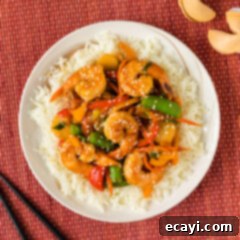
Easy & Flavorful Shrimp Stir Fry
IMPORTANT – There are often Frequently Asked Questions within the blog post that you may find helpful. Simply scroll back up to read them!
Print It
Pin It
Rate It
Save ItSaved!
Ingredients
- 2 Tablespoons olive oil
- 1 ½ Tablespoons minced garlic
- 1 pound large raw shrimp peeled and deveined
- 2 carrots julienned
- 1 red bell pepper julienned
- 1 yellow bell pepper julienned
- 1 cup snap peas
- ½ cup soy sauce
- 1 Tablespoon oyster sauce
- 1 Tablespoon sesame oil
- 2 teaspoons minced ginger
- 1 ½ teaspoons Asian sweet chili sauce
- 2 Tablespoons brown sugar
- 2 ½ Tablespoons cornstarch
- 1 cup sliced water chestnuts
- 3 green onions sliced
Things You’ll Need
-
Large deep sided skillet
-
Wooden spoon or rubber spatula
Before You Begin
- We left the tails on the shrimp for presentation in our photos, but you can remove them before cooking if you prefer.
- For the best texture, we highly recommend using raw shrimp. Pre-cooked shrimp tend to become rubbery and tough when stir-fried.
- If using frozen shrimp, make sure to thaw them completely before cooking. Place them in a sealed bag and submerge in cold water for 20-30 minutes. Always pat the shrimp thoroughly dry to ensure proper stir-frying.
- Don’t be afraid to customize! Toss in your favorite stir-fry veggies such as bok choy, asparagus, baby corn, broccoli, mushrooms, etc., when adding the carrots, bell peppers, and snap peas to the pan. Adjust cooking times based on vegetable hardness.
- For a smooth cooking process, practice “mise en place” – chop all vegetables, prepare your shrimp, and whisk together your sauce ingredients before you start heating the pan.
Instructions
-
Heat olive oil in a large deep-sided skillet or wok over medium-high heat. Add minced garlic and raw shrimp, stir-frying for 1-2 minutes until the shrimp begins to change color to pink and opaque.
-
Add the julienned carrots, bell peppers (red and yellow), and snap peas to the skillet. Toss everything together, stir-frying for another 2-3 minutes until vegetables are tender-crisp.
-
Pour in the combined soy sauce, oyster sauce, sesame oil, minced ginger, Asian sweet chili sauce, and brown sugar. Stir and toss vigorously to combine well, ensuring the sauce coats all ingredients.
-
Sprinkle cornstarch over the contents of the skillet and toss well to thicken the sauce. Finally, add the sliced water chestnuts and green onions. Toss again and continue cooking for 1-2 minutes to heat through and ensure the sauce reaches a glossy consistency. Serve immediately.
Expert Tips & FAQs Summary
- Store any cooled leftovers in an air-tight container in the refrigerator for up to 3 days.
- Avoid overcrowding your skillet for proper stir-frying; cook shrimp in batches if necessary.
- Use a high smoke point oil like olive, canola, or peanut oil.
- Adjust the Asian sweet chili sauce to your preferred spice level.
- This recipe is versatile and works well with other proteins like chicken, beef, or tofu.
Nutrition Information
The recipes on this blog are tested with a conventional gas oven and gas stovetop. It’s important to note that some ovens, especially as they age, can cook and bake inconsistently. Using an inexpensive oven thermometer can assure you that your oven is truly heating to the proper temperature. If you use a toaster oven or countertop oven, please keep in mind that they may not distribute heat the same as a conventional full sized oven and you may need to adjust your cooking/baking times. In the case of recipes made with a pressure cooker, air fryer, slow cooker, or other appliance, a link to the appliances we use is listed within each respective recipe. For baking recipes where measurements are given by weight, please note that results may not be the same if cups are used instead, and we can’t guarantee success with that method.
